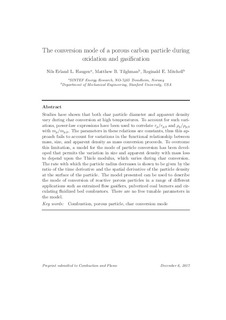| dc.contributor.author | Haugen, Nils Erland Leinebø | |
| dc.contributor.author | Tilghman, Matthew B. | |
| dc.contributor.author | Mitchell, Reginald E. | |
| dc.date.accessioned | 2020-02-28T11:32:03Z | |
| dc.date.available | 2020-02-28T11:32:03Z | |
| dc.date.created | 2013-10-21T12:57:06Z | |
| dc.date.issued | 2014 | |
| dc.identifier.citation | Combustion and Flame. 2014, 161 (2), 612-619. | nb_NO |
| dc.identifier.issn | 0010-2180 | |
| dc.identifier.uri | http://hdl.handle.net/11250/2644344 | |
| dc.description.abstract | Studies have shown that both char particle diameter and apparent density vary during char conversion at high temperatures. To account for such variations, power-law expressions have been used to correlate r p /r p,0 and ρ p /ρ p,0 with m p /m p,0. The parameters in these relations are constants, thus this approach fails to account for variations in the functional relationship between mass, size, and apparent density as mass conversion proceeds. To overcome this limitation, a model for the mode of particle conversion has been developed that permits the variation in size and apparent density with mass loss to depend upon the Thiele modulus, which varies during char conversion. The rate with which the particle radius decreases is shown to be given by the ratio of the time derivative and the spatial derivative of the particle density at the surface of the particle. The model presented can be used to describe the mode of conversion of reactive porous particles in a range of different applications such as entrained flow gasifiers, pulverized coal burners and circulating fluidized bed combustors. There are no free tunable parameters in the model. © 2013 The Combustion Institute. | nb_NO |
| dc.language.iso | eng | nb_NO |
| dc.rights | Attribution-NonCommercial-NoDerivatives 4.0 Internasjonal | * |
| dc.rights.uri | http://creativecommons.org/licenses/by-nc-nd/4.0/deed.no | * |
| dc.subject | Combustion | nb_NO |
| dc.subject | Porous particle | nb_NO |
| dc.subject | Char conversion mode | nb_NO |
| dc.title | The conversion mode of a porous carbon particle during oxidation and gasification | nb_NO |
| dc.type | Journal article | nb_NO |
| dc.type | Peer reviewed | nb_NO |
| dc.description.version | acceptedVersion | nb_NO |
| dc.source.pagenumber | 612-619 | nb_NO |
| dc.source.volume | 161 | nb_NO |
| dc.source.journal | Combustion and Flame | nb_NO |
| dc.source.issue | 2 | nb_NO |
| dc.identifier.doi | 10.1016/j.combustflame.2013.09.012 | |
| dc.identifier.cristin | 1059171 | |
| dc.relation.project | Andre: DE-FC26-10FE0005372 | nb_NO |
| dc.relation.project | Norges forskningsråd: 215707 | nb_NO |
| dc.relation.project | Norges forskningsråd: 193816 | nb_NO |
| cristin.unitcode | 7548,70,0,0 | |
| cristin.unitname | Termisk energi | |
| cristin.ispublished | true | |
| cristin.fulltext | postprint | |
| cristin.qualitycode | 2 | |

